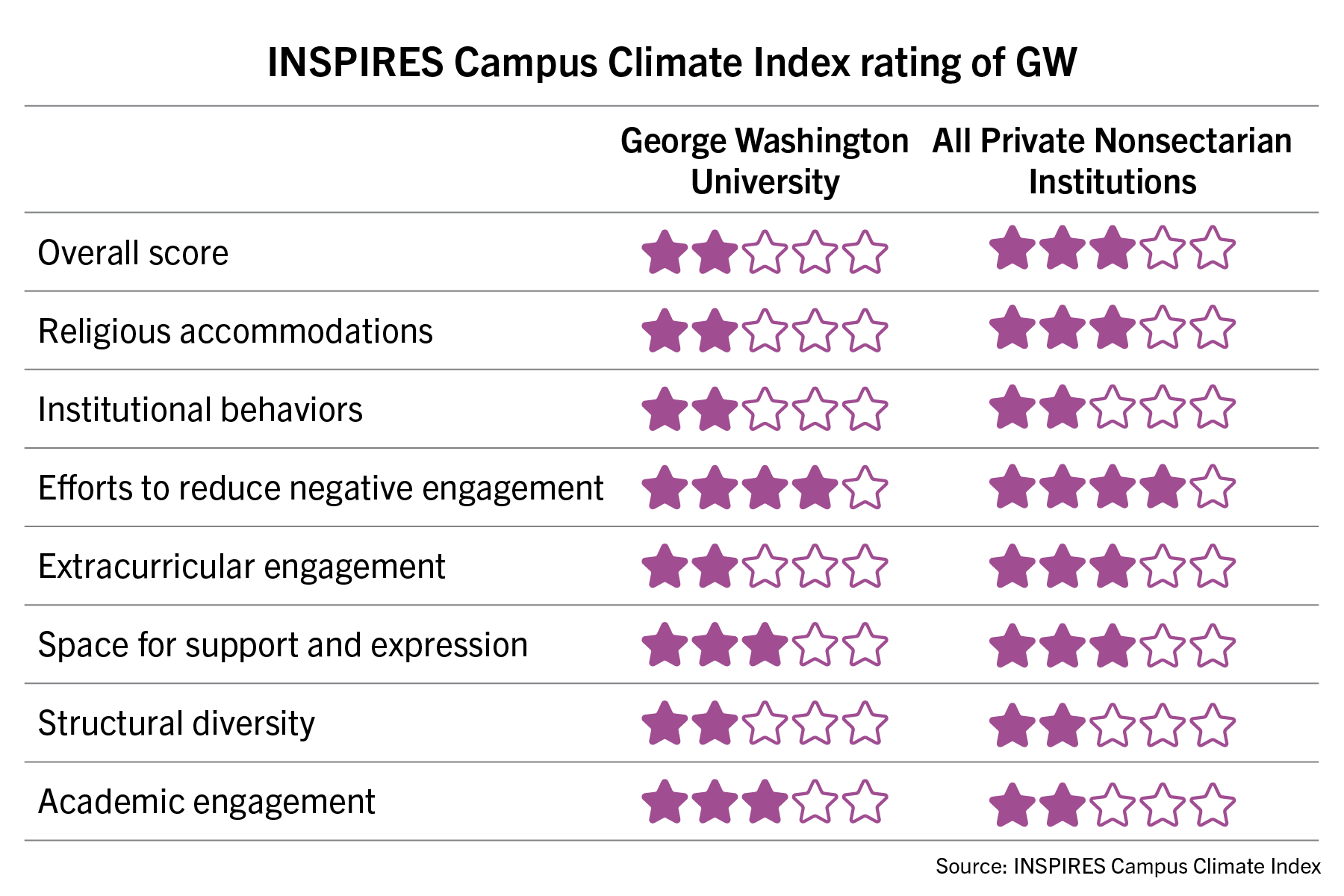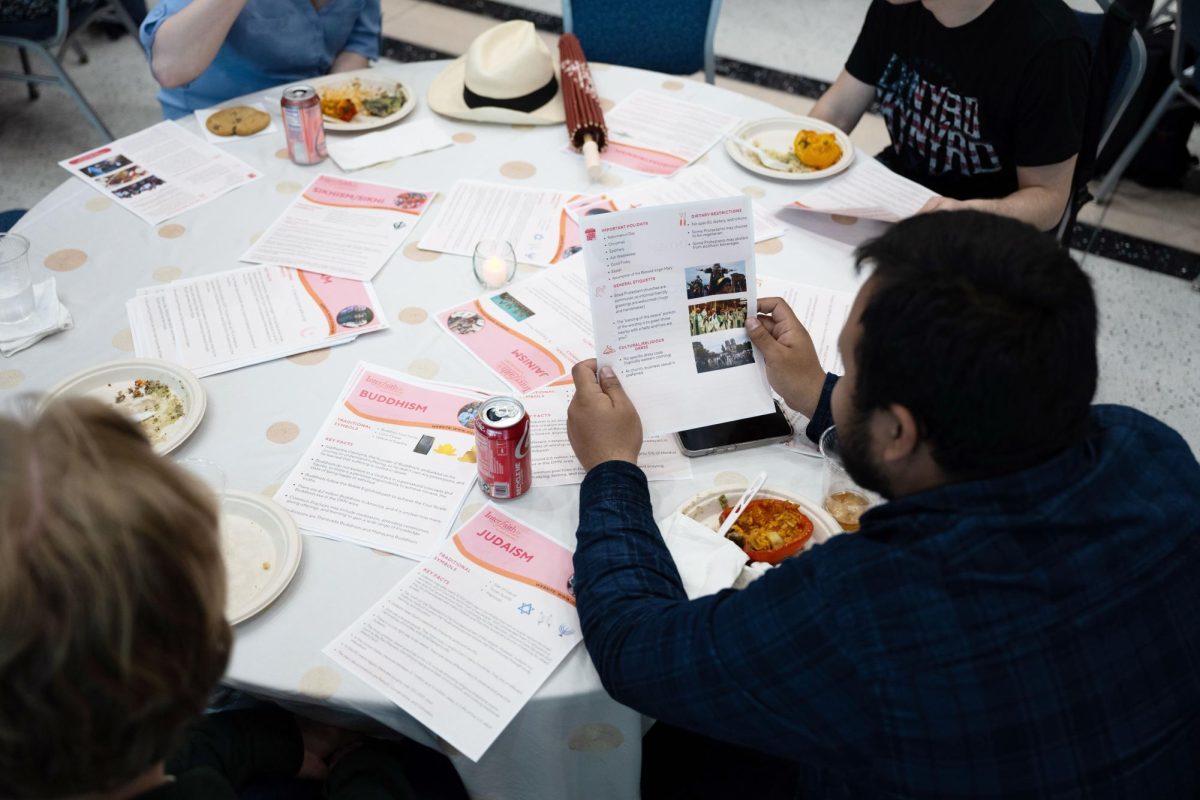A national database that evaluates a school’s efforts toward promoting an inclusive environment for students with different religious identities scored GW two out of five stars.
The University’s recent score on the Interfaith, Spiritual, Religious and Secular Campus Climate Index is one star lower than the average for the 30 participating nonsectarian, private institutions, according to the index’s website. As GW plans to launch this semester the new Center for Interfaith and Spiritual Life, religious student organization leaders said GW must use the results to guide and strategically support faith-based student organizations to ensure the center accommodates all religious students in the future.
“You can put up a sign, you can put up a symbol, you can put up a small statue or plaque, or whatever it is,” said Megan Clancy, the president of GW Catholics. “But that doesn’t actually, at the end of the day, mean anything if there is not the like, this structural support and the actual advocacy for the religious groups that are represented by those symbols.”
The INSPIRES Index, which colleges voluntarily opt into, requires a “campus representative” to complete the 53-part questionnaire about their campus climate. Colleges can opt out of publicly displaying their scorecard, but the index encourages schools to make them accessible. Of the more than 170 colleges participating in the index, 127 published their report, according to the website.
The report determines a college’s overall interfaith climate score based on their performance of the criteria in seven categories: religious accommodations, institutional behaviors, efforts to reduce negative engagement, extracurricular engagement, space for support and expression, structural diversity and academic engagement.

Compared to other private nonreligious universities, GW scored one star higher in academic engagement, one star lower in religious accommodations and extracurricular engagement, losing marks for criteria like the lack of interfaith community service opportunities and interfaith-focused living affinity groups. GW currently has nine living and learning communities and affinity housing in District House.
GW scored a two out of five for its dietary religious accommodations because some, but not all, dining halls have food options for religious dietary restrictions and accessible hours for students fasting. None of the three all-you-can-eat dining halls on both campuses open before 7 a.m., after suhoor, the meal Muslim people eat before sunrise to prepare for a day of fasting during Ramadan.
The University also got marked down for the lack of an exemption for religious students from the dining plan, nearby restaurants or grocery stores for religious dietary needs and transportation for students to access stores for religious dietary grocery shopping.
GW scored a three out of five on the academic engagement category, losing checks for the lack of an interfaith major or minor and required religious or interfaith courses in the core curriculum. Robert Eisen, a professor of religion and Judaic studies, said the University should support and expand the religion department, as the program has struggled to hire new faculty while the enrollment in the courses fill to capacity.
“Too often religion is treated as a subject that isn’t a serious academic discipline,” Eisen said. “But it is, it’s as serious as any other discipline being taught at GW.”
GW’s scores in institutional behaviors, structural diversity, space for support and expression and efforts to reduce negative engagement were average compared to private nonreligious universities, ranging between two and four stars.
Officials launched plans for the new interfaith center over the summer as a part of GW’s “Strengthening Our Community in Challenging Times” plan — which the University released in January to review free speech policies and bolster religious programming in response to campus tensions over the war in Gaza.
The center plans to hire an interfaith chaplain, a director to oversee its daily operations and a program coordinator to host events. A University spokesperson said updates about the center’s location and staff will be shared “soon” but did not specify a date or time frame.
“The new center will make critical improvements to the accessibility of religious resources and accommodations for our student body, and we hope this will make GW campuses more welcoming environments for all,” the spokesperson said in an email.
In June, officials removed the “religious life” tab on the Multicultural Student Services Center’s website, which contained information on interfaith programming that the MSSC used to host, including an annual week of religious and interfaith programming called Interfaith Week.
Robert Zayd KiaNouri-Zigmund, the MSSC’s former graduate assistant for religious and spiritual life, said he resigned from his position in the spring after officials reportedly canceled the center’s plans for the week and transferred religious and spiritual life to the Division for Student Affairs.
Student organization leaders said the new interfaith center should welcome all perspectives among the diverse array of beliefs, religions and faiths at GW, adding that officials should work with students to help facilitate programming.
Junior Amina Iman, the Islamic affairs chair for the Muslim Students’ Association, said officials should regularly check in with faith-based student organizations to identify areas of necessary support for religious students. She said the diversity of the Muslim community could be a strength or weakness for the interfaith center, depending on if the center’s work is “politicized” or “certain groups” are favored.
“I’m interested in seeing what that space would look like,” Iman said. “I do think it is needed, but I think that it also has to be navigated and led in a very strategic manner to ensure that the purpose of it, which is to support students, is actually met and consistently worked toward.”
Junior Aditi Venkateswaran, a co-president of the Hindu Student Association, said GW could connect with local temples to ease the stress of inviting priests from student organizations. She said the group is working with the DSA to build a Dharmic prayer space on the fourth floor of the student center, similar to the division’s work last year with MSA to renovate the musalla.
“It’s just something so that people can go in at any time and go pray whenever they want to,” Venkateswaran said.
Junior Aidan Cullers, a co-president of the Jewish Student Association, said he wants to see the University address consistent dining concerns among students with religious dining restrictions, like better food labeling and expanded kosher options in dining halls. He said Zingers, the kosher cafe inside the GW Hillel building, is closed during Passover, as the holiday restricts how much an individual can work, leading other cultural spaces like Hillel and Rohr Chabad Center at GW to cater food for students.
“That’s like the only option for students to eat except, unless they go to buy through Whole Foods and Trader Joe’s, which on a limited budget, can be a significant restriction and significant challenge,” Cullers said.
Higher education interfaith experts said the index provides a benchmark tool for universities to see how they can better accommodate students.
Vidal Dickerson, the chief diversity, equity and inclusion officer at Christopher Newport University, said the index provides a “starting point” for colleges and a lower score may represent structural obstacles to accommodating religious students within an institution, like low funding and space availability.
“When you think about it as a tool, it does give us space to look at what is our reality,” Dickerson said. “It helps us to see our reality, it also helps us to see opportunity.”
Matt Hartley — the former director of the University of North Florida Interfaith Center, which closed earlier this year due to the state’s board of governors passage of a bill to limit funding for diversity, equity and inclusion programs — said officials would benefit from collecting and releasing a report on school’s religious makeup, which the University does not currently track, to find areas to accommodate those specific populations like establishing prayer spaces for different religions.
The University currently offers at least one prayer or medication room on the Foggy Bottom, Mount Vernon and Virginia Science and Technology campuses, according to the diversity, equity and inclusion action plan released Friday.
“If we’re thinking about inclusion, then inclusion is not just about cultural identity, but also about religious identity, which might include certain practices that affect what campus looks like,” Hartley said.





